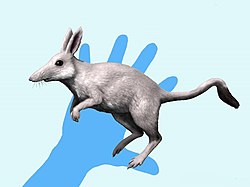| Fredszalaya Temporal range: Late Oligocene (Deseadan) | |
|---|---|
| Scientific classification | |
| Domain: | Eukaryota |
| Kingdom: | Animalia |
| Phylum: | Chordata |
| Class: | Mammalia |
| Order: | † Sparassodonta |
| Family: | † Borhyaenidae |
| Genus: | † Fredszalaya Shockey & Anaya, 2008 |
| Type species | |
| Fredszalaya hunteri Shockey & Anaya, 2008 | |
Fredszalaya is an extinct genus of omnivorous mammal, belonging to the order Sparassodonta. It lived during the Late Oligocene, and its fossilized remains were discovered in South America.




